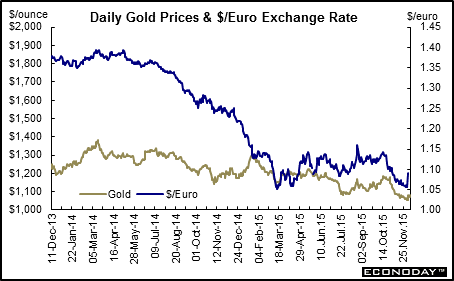
|
Long Term Perspective Gold is a special metal. It has long been considered a hedge against inflation even though it has not always kept up with inflation. Gold is also considered a safe-haven investment in times of uncertainty such as during war or during economic, financial and political turmoil. Yet, in recent years, more than one central bank has announced its intention to sell gold reserves. Could gold be losing some of its luster? Also, many investors are now viewing oil as an inflation hedge, somewhat softening the demand for gold.
Despite all its attributes, some Fed officials still consider gold a primary indicator of inflationary pressures. However, if gold prices rise because of political turmoil, this doesn't mean that inflation is around the corner. Thus, it is very important to consider all factors that can cause gold prices to fluctuate. Over the past 10 years or so, one can make the case that gold fluctuates with the dollar. Indeed, the graph below shows gold falling when the trade weighted dollar rises, and conversely gold rising when the trade weighted dollar falls. And in fact a declining dollar can have significant inflationary effects as prices of foreign-produced goods become more expensive to U.S. consumers and businesses. But it was a rising dollar during 2015 that led to the opposite, imported deflation as U.S. buyers of foreign goods got more for their dollars.
During 2009 through 2011, gold rose significantly on concerns over the inflationary risks of Federal Reserve stimulus, rising federal deficits, potential default on periphery European debt, and also over unrest in North Africa and the Middle East. Gold hit a high of $1,889.70 in August 2011. Slower economic growth and lessened inflation risk, together with the unwinding of quantitative easing, tugged down on gold in 2013 and 2014. By mid-2015, gold had fallen under $1,100 where it held into year end.
For the dollar, it slipped in mid-2009 on fears of rising inflation and in late 2009 over concern over a ballooning federal deficit. But the dollar gained during early 2010 over concern about bank loan losses in Europe and a slowing in the continent. The dollar then softened in late 2010 and early 2011 as worries eased over European sovereign debt. But the dollar rebounded in 2012 and into mid-2014 as the U.S. recovery gained traction and Europe weakened. It was heightened concerns over Greek debt and the country's membership in the euro that sent the euro tumbling in 2015 and the dollar rising sharply.
Short Term Perspective Soft global growth and easing hostilities between Ukraine and Russia led gold to ease in late 2014. In very early 2015, gold rebounded briefly on flight to safety as the price of oil plunged. The dollar found support from late 2012 through 2015 on relatively stronger U.S. growth. The European Central Bank's announcement of quantitative easing pulled the euro down sharply in January 2015. When investors believe that the Fed will raise rates or that overseas central banks will cut rates, the dollar appreciates. When investors believe that the Fed is done raising rates or that foreign central banks will raise rates, the dollar declines in the FX market. As of December 2015, gold settle was steady near $1,050 while the euro was at $1.0900.
|
|||||||
| Legal Notices | ©Copyright 1998-2024 Econoday, Inc. |
powered by
![[Econoday]](images/logo.gif)
![[Apple App Store]](/images/AppleAppStore.png) ![[Econoday on Kindle]](/images/kindle.jpg) 
|
||||||

